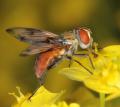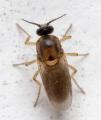Diptera.info :: Family forums :: Asilidae Forum
|
Brazil Asilidae - prob. Cyrtophrys sp.
|
|
| jgruber111 |
Posted on 05-01-2020 21:48
|
|
Member Location: Madison, WI, USA Posts: 355 Joined: 10.03.17 |
Found at Reserva Ecológica de Guapiaçu (REGUA), in Cachoeiras de Macacu municipality in state of Rio de Janeiro in southeastern Brazil on 1.XII.2019. Bigger flickr versions: Number 1. Number 2. Number 2. jgruber111 attached the following image:  [195.14Kb] Edited by jgruber111 on 09-04-2020 01:56 |
| Eric Fisher |
Posted on 16-01-2020 23:45
|
|
Member Location: California Posts: 435 Joined: 19.05.06 |
Asilidae; prob. Dasypogoninae female -- need to examine 'in hand.' |
|
|
|
| jgruber111 |
Posted on 17-01-2020 19:36
|
|
Member Location: Madison, WI, USA Posts: 355 Joined: 10.03.17 |
Thanks. |
| Chris Cohen |
Posted on 25-03-2020 21:46
|
|
Member Location: Posts: 211 Joined: 15.02.19 |
This robber has been observed in REGUA a few times before (e.g. https://www.inaturalist.org/observations/8382773, https://www.inaturalist.org/observations/8895809). Important characters I can distinguish: cell m3 appears to be closed (more obvious in Flickr photos), anatergite is bare, and marginal scutellar bristles are absent. Using Papavero, Artigas & Lamas (2009) this would key out to Phonicocleptes/Blepharepium, which is obviously wrong. Assuming cell m3 is actually open, it would key out to Tocantinia, which is also not quite right (marginal scutellar bristles are present in that genus). So, unless I'm missing something, I would guess this is also an undescribed genus. |
|
|
|
| jgruber111 |
Posted on 26-03-2020 13:45
|
|
Member Location: Madison, WI, USA Posts: 355 Joined: 10.03.17 |
Thanks much for the tentative det and detailed info Chris. I had seen those other shots and they drew me to that area. I actually have a really nice series of one of these (first shots = https://www.flickr.com/photos/7432824@N07/49484514878/) that I will post soon. If I remember correctly I think I have some dorsal shots. Edited by jgruber111 on 26-03-2020 13:46 |
| Chris Cohen |
Posted on 29-03-2020 22:25
|
|
Member Location: Posts: 211 Joined: 15.02.19 |
After looking at the newly posted Flickr images of the male, I believe I missed an important detail in my initial ID - the antennae. There is only one flagellomere (not two as I originally assumed), and what appears to be a small dorsal spine. Taking into account the wing venation (cell r1 open and cell m3 closed), this would key out to Cyrtophrys. This genus seems to be a pretty good match based on the illustrations of the antennae and head that I have seen, as well as the description in Hull 1962. It has also been collected in Rio de Janeiro. At the current time that is my best guess for the identity of this fly. Cool!
Edited by Chris Cohen on 29-03-2020 22:33 |
|
|
|
| Jump to Forum: |














